Technology
Level Up Your Marketing with These 10 Content Marketing Tools
Published
4 months agoon
By
Skylar Lee
Content marketing has evolved rapidly. And in 2025, it’s more than just blog posts and email campaigns. With AI-driven content marketing tools, shifting social platforms, and higher audience expectations, you need the right stack of tools to stay ahead.
Types of Content Marketing Tools
There are various content marketing strategies, such as blogging, email marketing, video marketing, social media marketing, and more. That said, if you’re tackling different marketing types, you need assorted tools to make your content marketing strategy work.
But what types of tools do you need?
- Analytics
- Management
- Creation (writing blogs or copy, graphics, and videos) and editing
- Publishing
- Promotion
Here are a few tools to check out if you’re looking for the most popular content marketing tools:
1. Penji
Great content needs great design—and that’s where Penji comes in. As an unlimited graphic design service, Penji helps marketers scale visual content quickly without hiring a full-time designer. Whether you’re creating social media graphics, blog illustrations, ad creatives, or infographics, Penji’s team of vetted designers can handle it all.
Features:
- Unlimited design requests and revisions
- 24–48 hour turnaround for most projects
- Built-in platform for submitting briefs, reviewing, and leaving feedback
Pricing:
- Business – $499/mo
- Marketing & Ads – $995/mo
- Agency – $1,497/mo
2. HubSpot
If you’re looking for an all-in-one platform to manage your content marketing, HubSpot remains one of the most powerful tools. Trusted by customers globally, HubSpot helps teams streamline content creation, automate marketing workflows, and track ROI with ease. It also offers access to the HubSpot Academy, where marketers can upskill with free certifications and in-depth courses.
Features:
- Create and manage blogs, emails, landing pages, and social media content
- Built-in SEO recommendations and content strategy tools
- AI-powered content assistant to generate and optimize copy
Pricing (Marketing Hub for Individuals and Small Teams):
- Free tools
- Marketing Hub Starter – $9/mo/seat (billed annually)
- Starter Customer Platform – $9/mo/seat (billed annually)
- Marketing Hub Professional – US$800/mo (billed annually)
3. SEMRush
If blogging or SEO-driven content is at the heart of your marketing strategy, SEMrush is a powerhouse you can’t afford to skip. This all-in-one platform supports everything from keyword research to competitive analysis, content optimization, and even AI writing assistance. In 2025, SEMrush continues to be a go-to tool for marketers who want to improve organic visibility and outrank competitors.
Features:
- In-depth keyword overview and keyword manager
- Organic research and traffic analytics
- Track competitor rankings and backlink profiles
Pricing (as of 2025):
- Pro – $139/mo
- Guru – $249/mo
- Business – $499/mo
4. Trello
If you’re looking for a simple and highly visual way to manage your content marketing workflow, Trello remains a top choice. This kanban-style project management tool, now fully integrated with Atlassian’s ecosystem, makes it easy to organize campaigns, build editorial calendars, and collaborate with your team in real-time. With its intuitive interface and powerful automation options, Trello is perfect for small teams and solo marketers alike.
Features:
- Drag-and-drop kanban boards to organize tasks and campaigns
- Customizable cards with checklists, attachments, and due dates
- Built-in Butler automation for recurring tasks
Pricing:
- Free
- Standard – $6/user/mo
- Premium – $12.50/user/mo
- Enterprise – $210.00 annual price per user
5. Clipchamp
If you’re new to video marketing, Clipchamp is one of the most user-friendly video editing tools you can find. Now fully integrated with Microsoft 365, Clipchamp allows creators to produce high-quality videos with minimal experience. Its drag-and-drop editor, built-in templates, and AI-powered tools make it ideal for businesses that want to boost engagement through short-form or promotional videos.
Features:
- Customizable video templates for YouTube, Reels, and more
- AI voiceover generator with multiple languages and tones
- One-click brand kit for logo, fonts, and color consistency
Free
- Free
- Premium – $11.99 per month
6. Google Docs
A staple from Google, Google Docs remains one of the most versatile content writing tools. Whether you’re drafting blog posts, brainstorming outlines, or collaborating with a remote team, Docs offers a seamless writing experience in the cloud. Its integration with Google Drive, Google Workspace, and now Gemini AI makes it even more powerful for content marketers.
Features:
- Real-time collaboration with comments, chat, and suggestions
- Voice typing for hands-free note-taking
- Version history to track edits and revert changes
Pricing:
- Free (with a Google account)
- Additional features available via Google Workspace plans
7. Google Analytics
Track essential metrics like click-through rates, user engagement, and conversion paths with Google Analytics 4 (GA4). As Google’s latest analytics platform, GA4 is built for the privacy-first era and gives marketers a deeper, event-based view of customer behavior across web and app. It’s one of the most essential content marketing tools today, offering seamless integration with other Google products like Google Ads, Looker Studio, and Search Console for a more connected marketing strategy.
Features:
- Event-based tracking for detailed user interactions
- Predictive metrics powered by machine learning (e.g., purchase probability, churn)
- Integration with Google Ads for campaign performance
Pricing: Free
8. Grammarly
No matter how compelling your content is, grammar and clarity still matter. That’s where Grammarly comes in. This tool has evolved beyond basic grammar checks—it’s now an AI-powered writing assistant that helps you refine tone, rewrite awkward sentences, and even generate new content ideas.
Features:
- Real-time grammar, spelling, and punctuation checks
- Tone detection and tailored suggestions (e.g., confident, friendly, formal)
- Sentence rewrites for clarity and flow
Pricing:
- Free – Basic grammar and spelling checks
- Premium – $12/mo (advanced writing suggestions and tone improvements)
- Business – $15/mo per user (team-focused features and brand tone settings)
9. WordPress
You can’t have a strong content strategy without a place to publish, and WordPress is still the world’s leading CMS in 2025. Whether you’re running a blog, building landing pages, or managing a full-scale eCommerce site, WordPress offers the flexibility and scalability content marketers need. With its intuitive block editor, vast library of plugins, and support for AI writing tools, it’s ideal for both beginners and pros.
Features:
- Drag-and-drop Gutenberg block editor for effortless content layout
- Seamless integration with plugins like Yoast SEO, Elementor, and Jetpack
- Full control over design, hosting, and content structure
Pricing:
- Free – $0
- Personal – $4/month, billed annually
- Premium – $8/month, billed annually
- Business – $25/month, billed annually
- Commerce (eCommerce plan) – $45/month, billed annually
10. MeetEdgar
To maximize your content marketing efforts, you need a reliable content promotion tool, and MeetEdgar is a solid option. Known for its evergreen content automation, MeetEdgar helps you post consistently without manual upkeep, making it ideal for solo creators and small teams.
Features:
- Schedules and automatically recycles evergreen social posts
- Organizes content via customizable categories
- Stores your posts in a dynamic content library for reuse
Pricing:
- Eddie Plan ~$24.91/mo
- Edgar Plan ~$41.58/mo
Final Thoughts
Planning your content marketing strategy can be a challenge. After all, you must consider written content, visuals, schedules, and more. However, it is manageable thanks to reliable content marketing tools. The tools listed above are ideal for businesses new to content marketing or those on a budget.
You may like
Business
How Marketing Optimization Tools Level Up Your Marketing Game
Published
5 days agoon
December 12, 2025By
Skylar Lee
While many companies and small businesses struggle to capture their target audience’s attention amidst competition from giant brands, it’s clear that marketing needs to be taken up a notch. To do this, it requires marketing optimization tools to not only achieve marketing objectives but also generate leads. But how do you go about optimizing your marketing efforts and what tools can help?
1. Make Use of Data
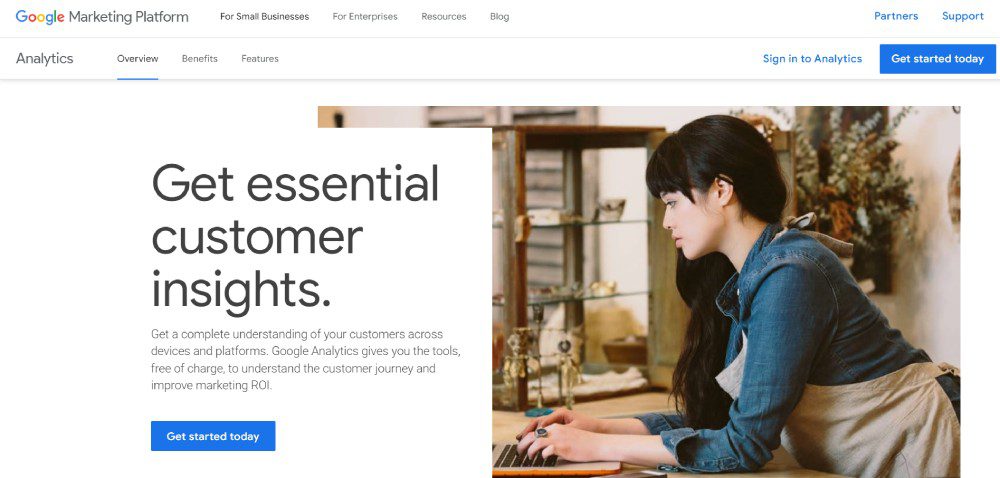
According to Hubspot, marketing in 2025 will heavily focus on data. That said, data will give you insights into your target audience. Plus, you can better understand how your business works better through data. Fortunately, many marketing optimization tools have data and analytics to help you reach targets.
If your strategy is understanding your audience better through data, Google Analytics is your best free option. With Google Analytics, you’ll know where your users are coming from and how many of them are visiting your website.
Another data-heavy strategy is social media marketing. After all, you don’t want your social media marketing efforts to go in vain. Although MeetEdgar is primarily a social media scheduler, it will help you understand which of your posts are doing great in engagement. Plus, you can make decisions regarding your other non-performing posts.
2. Focus on SEO
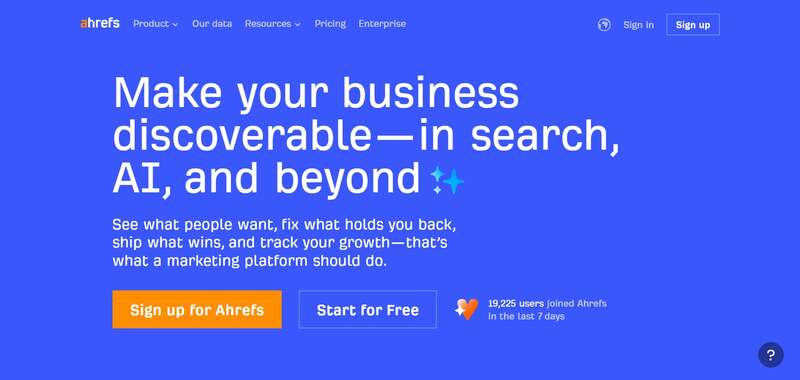
Data isn’t enough when optimizing your marketing campaigns or strategies. Marketing strategies are best served with the help of SEO. You shouldn’t overlook or underestimate the impact of what SEO can do for your business. After all, you want to drive customers to your website, right? SEO is your best bet in getting more clicks and visits. Plus, you can earn your place on the coveted first page of search engines.
With SEO, you don’t have to overcomplicate it. Plus, you don’t want to skimp on SEO, especially if you want visitors to flock to your site. You can use one simple tool to help you research keywords, explore your competitors, and track your progress. Ahrefs is one of the tools you should have in your arsenal. They have an all-in-one tool ready to help you learn about your content, links, competitors, and more!
3. Stay Active on Social Media

Social media platforms are the best places to reach your target audience. You can post on Facebook, Instagram, Twitter, and TikTok to engage with your audience and promote your products or services. But posting on social media requires constant efforts and well-thought-out strategies. You need to post regularly with the right content, copy, and visuals to attract your target audience. Content creation tools like graphic design software and video editors will help you meet your social media marketing goals.
Canva is the go-to for many marketers because of its ease of use and UI. Plus, you can make graphics in minutes. Meanwhile, Clipchamp is a trusted name in video editing. Marketers can use templates to create videos in a snap. Plus, they can make compelling videos by adding filters and AI voiceovers.
4. Keep Content Consistent
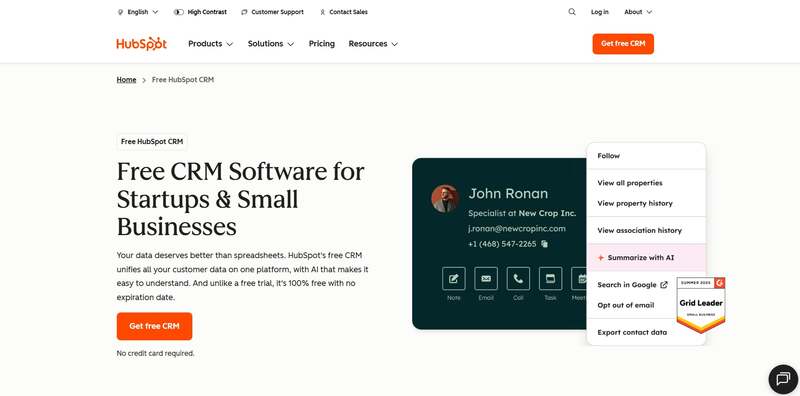
During the planning stages, it’s important that your content should also be ready before it’s published. If you are launching a marketing campaign, you need your visual assets and marketing copy prepared. But you don’t create for creation’s sake. You need to keep your messaging and visuals consistent on every platform.
You want to ensure that people across various channels view and interact with your campaign assets while getting your main message out.
There are a couple of marketing optimization tools for this strategy:
- Hubspot is the popular choice for content marketing since you can publish and schedule your blogs on this platform.
- Like with social media marketing, you need content creation tools. However, an alternative to content creation tools is unlimited graphic design and video editing services. For graphic design, you can rely on Penji. You can request your graphics in one place while you work on your company. Meanwhile, Video Husky is a trusted video editing service helping you with short-form and long-form videos.
- Email marketing is another content strategy you should consider when reaching your audiences. Mailerlite is your best bet in achieving your email marketing goals.
5. Research Your Competitors
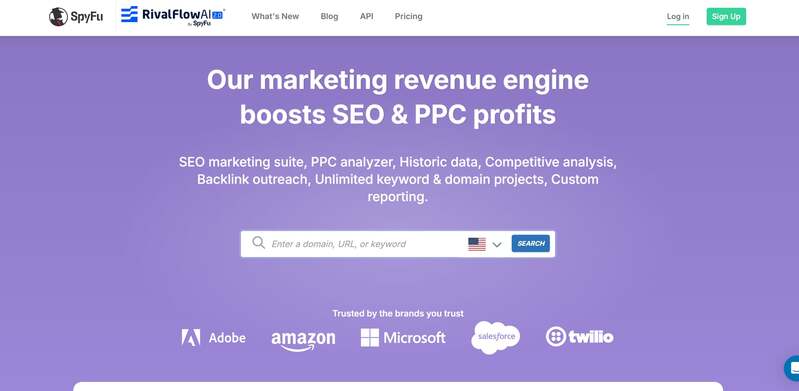
Aside from learning about your audience, you should also keep an eye out for your competitors. After all, you want to see how your target audience responds to their posts. Plus, you want to compare how different your websites could be. This will give you an idea of how to improve your posts and websites.
Although Ahrefs has a competitor research tool, an alternative to this is SpyFu. They specialize in analyzing competitor keywords, traffic, ads, and domains.
Other Marketing Optimization Tools to Use:
Marketing Automation
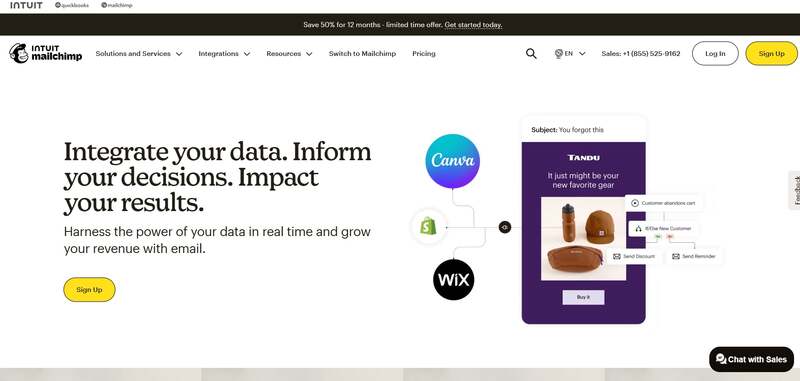
Marketing automation tools have been the go-to applications for most marketers. After all, marketing automation streamlines your work. Plus, you can leave it to the AI or other automated sequences to do your job for you. That said, there are tons of marketing automation tools.
One stands out from the rest, and that is MailChimp. Although known as an email marketing tool, they have a marketing automation feature by building relationships with your customers and ad retargeting.
Customer Relationship Management
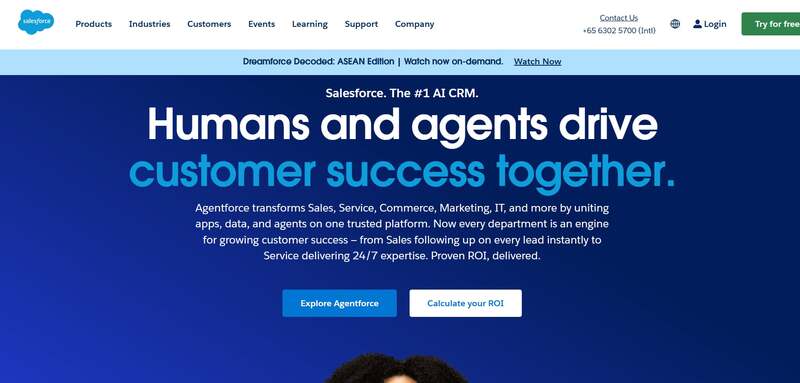
Customer relationship management (CRM) software is one tool you need to reach more customers. This works best if you have an email marketing strategy. And if you need a CRM tool, Salesforce is the highly recommended one. You can run your marketing campaigns on their software. Plus, you can nurture leads and provide the best customer experience.
Project Management

One overlooked marketing optimization tool is project management. You should use a project management tool to help you get on track with your campaigns. Asana is a must-subscribe project management tool for marketing. You can collaborate with your teammates, assign them various projects, and organize them for each strategy.
Final Thoughts
In the competitive landscape of 2026, optimizing your marketing strategy is no longer optional, it’s essential. It can be challenging to entice your target audience digitally nowadays, especially if you’re hesitant to use optimization tools. That’s why it’s essential to use them to help you achieve your marketing goals. And with the tools above, you can be on your way to reaching your audience and increasing your sales.
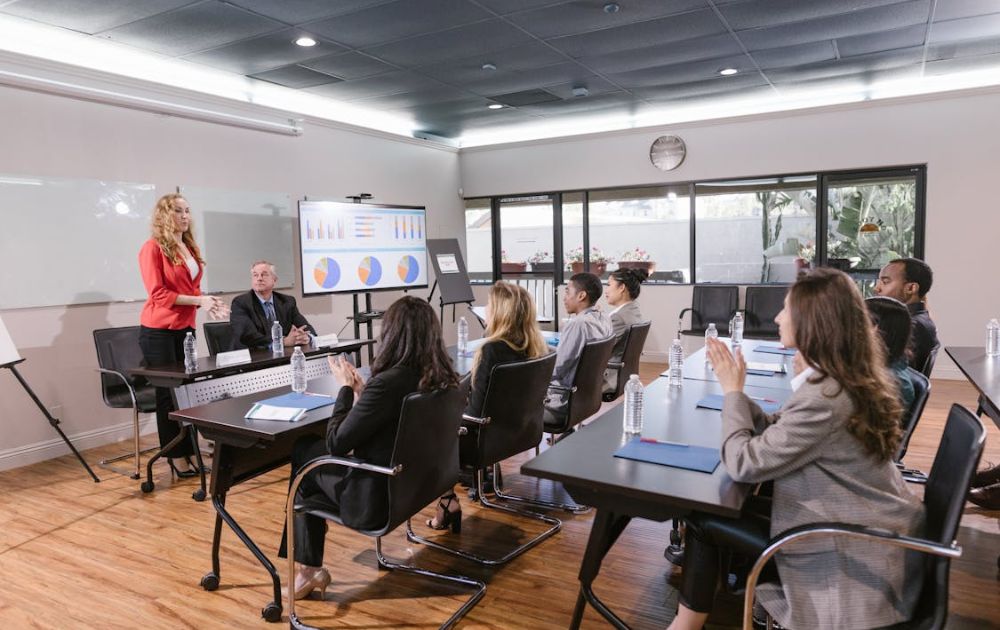
Are you looking to create a stunning presentation that keeps your audience engaged? It would be best if you had excellent presentation software to take your slides to new heights. Let’s review the ten best presentation software in 2026 so you can choose the best for your business.
1. Visme
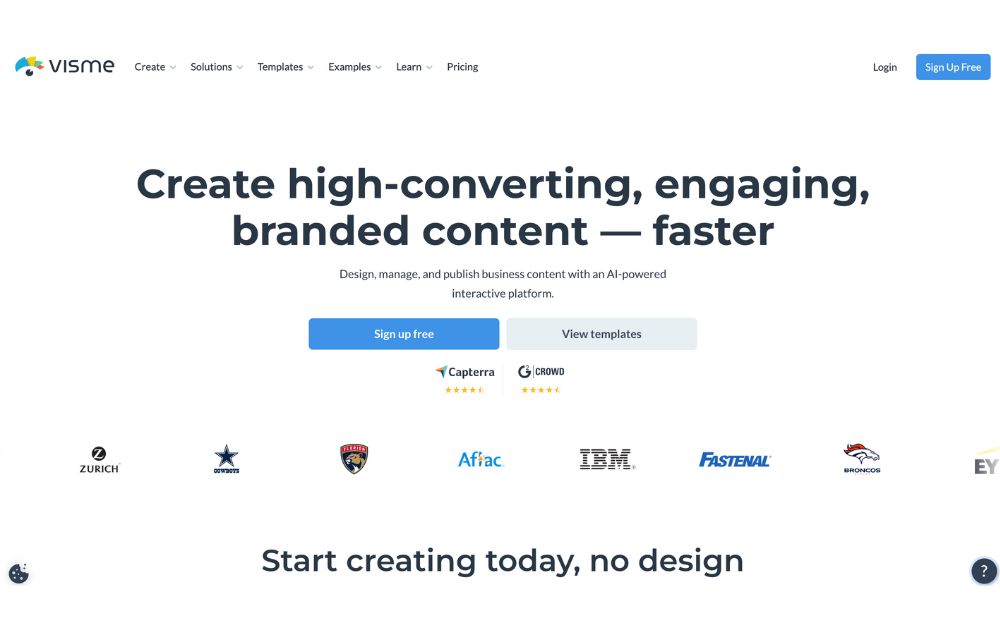
Visme is a cloud-based presentation software that enables users to create visually engaging and interactive presentations, infographics, and other visual content. Its user-friendly drag-and-drop interface makes it easy for users to add text, images, charts, and other elements to their presentations. Likewise, it offers design options like custom color schemes, fonts, and layouts. On top of that are interactive features like videos which can engage audiences and make the presentation more interactive.
Visme also offers collaboration features that allow multiple users to work on a presentation simultaneously. Users can also share it for feedback and review.
Best for: Visme is perfect for small and large businesses, marketers, project managers, content creators, and educators.
Pricing:
- Personal: $12.25/month paid annually
- Business: $24.75/month paid annually
- Enterprise: Custom
2. Prezi

Prezi offers a great alternative to the typical presentation format that goes slide by slide. Prezi’s creative idea is to create an animated, non-sequential flow of slides with hidden topics and subtopics until you zoom in. While Prezi’s interface can be slightly complicated, it is a good option for people who want to add a creative touch to their slides.
Best for: Businesses and educators.
Pricing:
- Free plan: $0
- Plus: $15/month
- Premium: $25/month
- Teams: Starts at $39/month
3. Google Slides
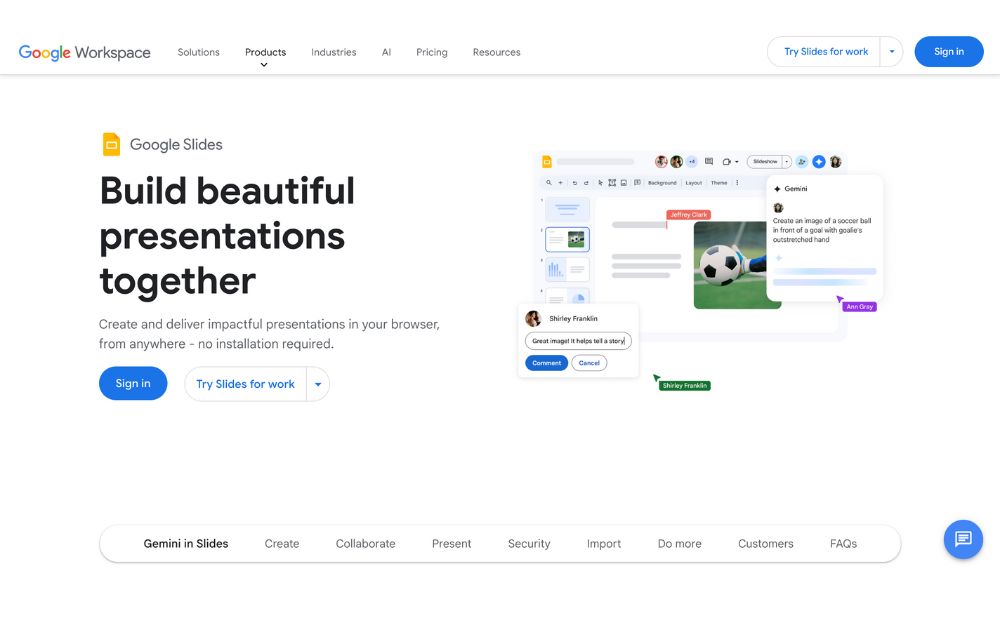
One of the most used tools online, Google Slides is a web-based presentation software part of the Google Suite of productivity tools. Google Slides is a web-based presentation software part of the Google Suite of productivity tools. It enables users to create, edit, and share presentations online, and it is similar in functionality to other presentation software such as Microsoft PowerPoint.
With Google Slides, users can create a new presentation from scratch or use one of the many templates provided by Google. Users can add text, images, charts, and other elements to their presentations using a simple drag-and-drop interface. Google Slides also offers a wide range of design options, including custom color schemes, fonts, and layouts, as well as the ability to add animations, transitions, and other effects to slides.
Best for: Business professionals, educators and students
Pricing:
- Free to use for anyone with a Google account.
- Plans for business accounts start at $6.30/user/month.
4. Keynote
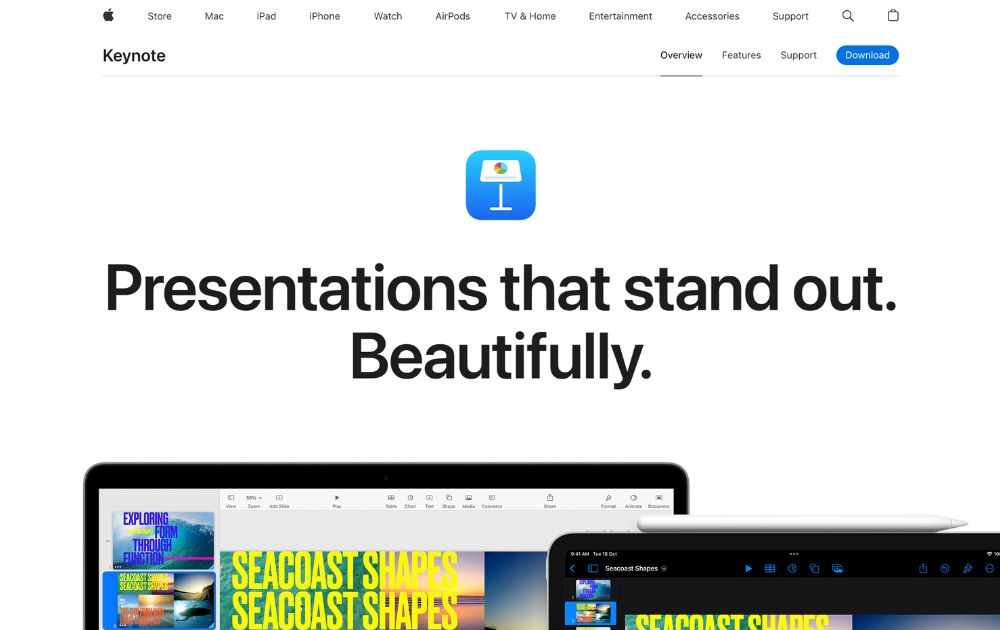
Keynote is an Apple presentation software and one of the original alternatives to Microsoft’s PowerPoint. The best thing with Keynote is that it is the most similar to PowerPoint and Google Slides.
Best for: Keynote is good for businesses, educators, and individuals.
Pricing: Free for anyone with Apple ID
5. Microsoft PowerPoint
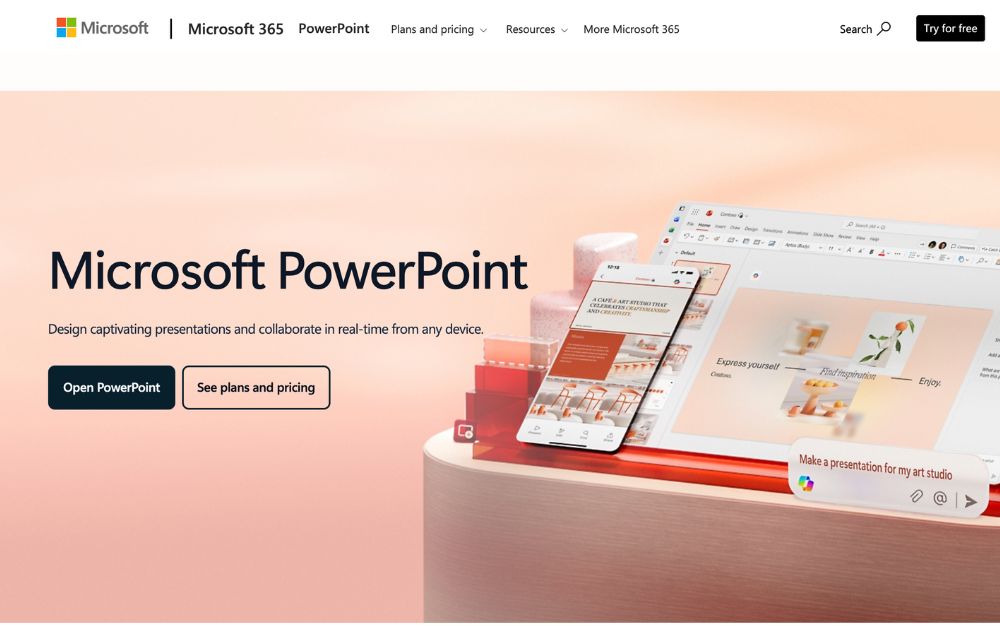
Microsoft PowerPoint is the world’s most widely used presentation software. It is similar in functionality to other presentation software such as Apple Keynote and Google Slides.
PowerPoint also offers collaboration capabilities, including sharing presentations for feedback and review. It also allows users to work on presentations with other users simultaneously. Plus, it enables users to export their presentations in PDF, PPTX, and JPG formats.
Best for: Businesses, individuals, students, teachers and individual who use a Windows PC or device.
Pricing:
- Free to download on desktop or mobile devices
- Microsoft 365 Personal starts at $9.99/month
6. Ludus
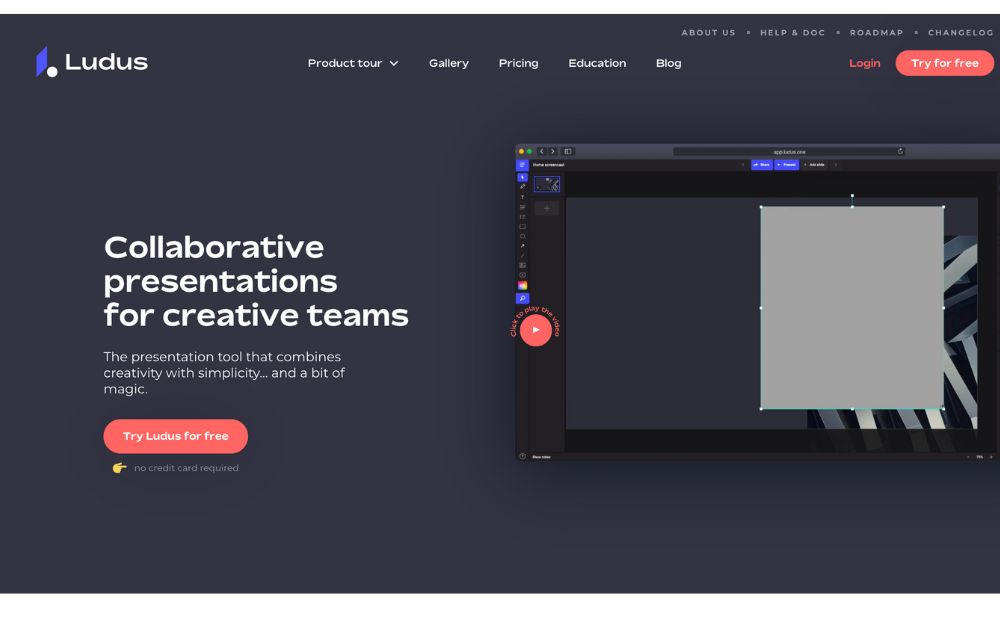
Ludus is one of the coolest presentation tools available online. The main attractions of Ludus are the clean black screen to edit on and the number of integrations that provide importing capabilities for all sorts of content.
Best for: Designers and business owners
Pricing:
- Starts at $14.90/month for teams of 1-15 people.
- Offers a 30-day free trial
7. Slides
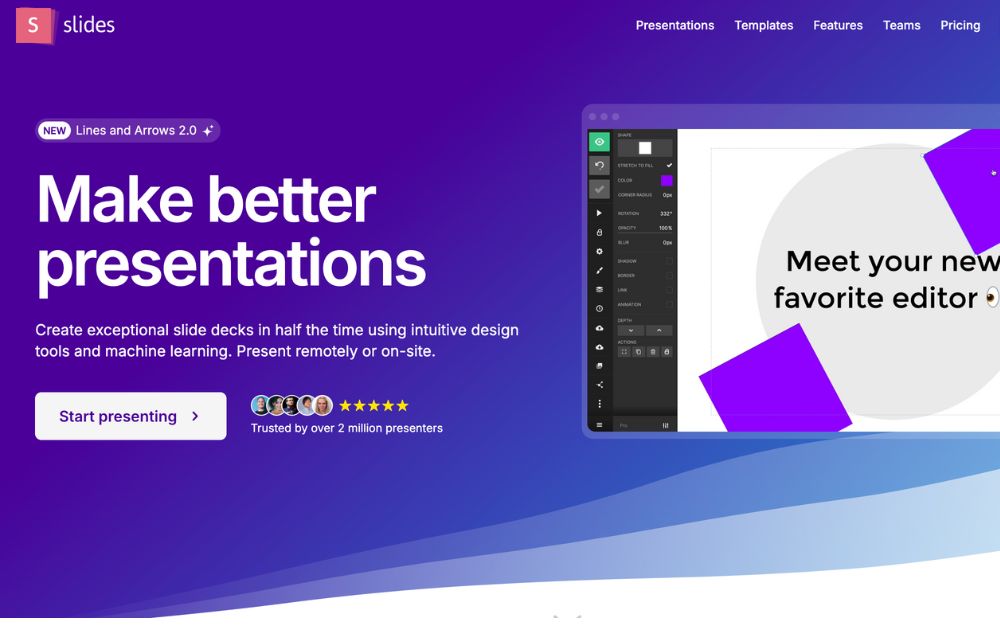
Slides promotes itself as “pixel-perfect” presentation software. Its editor includes a built-in grid to help with composition. Slides have a lower cost at the highest price tag, which suits smaller businesses.
Best for: Small business owners, startups, and individuals.
Pricing:
- Free plan
- Paid plans start at $5/month
8. Slidebean
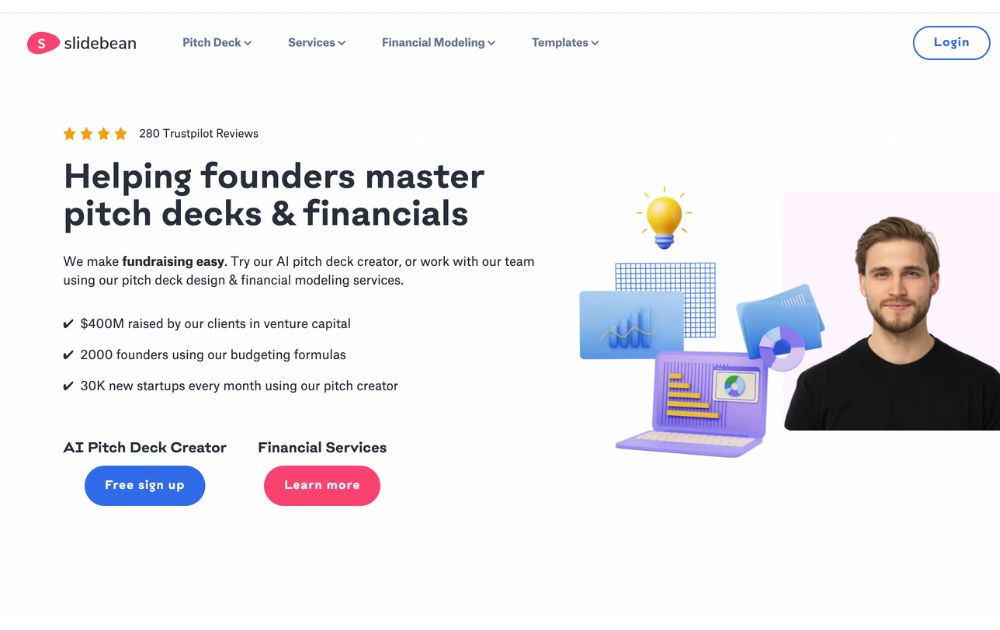
SlideBean is a cloud-based presentation software that enables users to create visually engaging and professional presentations quickly and easily. The software is developed as user-friendly and intuitive, making it easy for users to create high-quality presentations without any design experience.
Slidebean also takes pride in its AI pitch deck creator, which offers a fast way to create a presentation.
Best for: Small businesses, startups, and entrepreneurs.
Pricing:
- Paid plans start at $12/month
9. Beautiful.ai
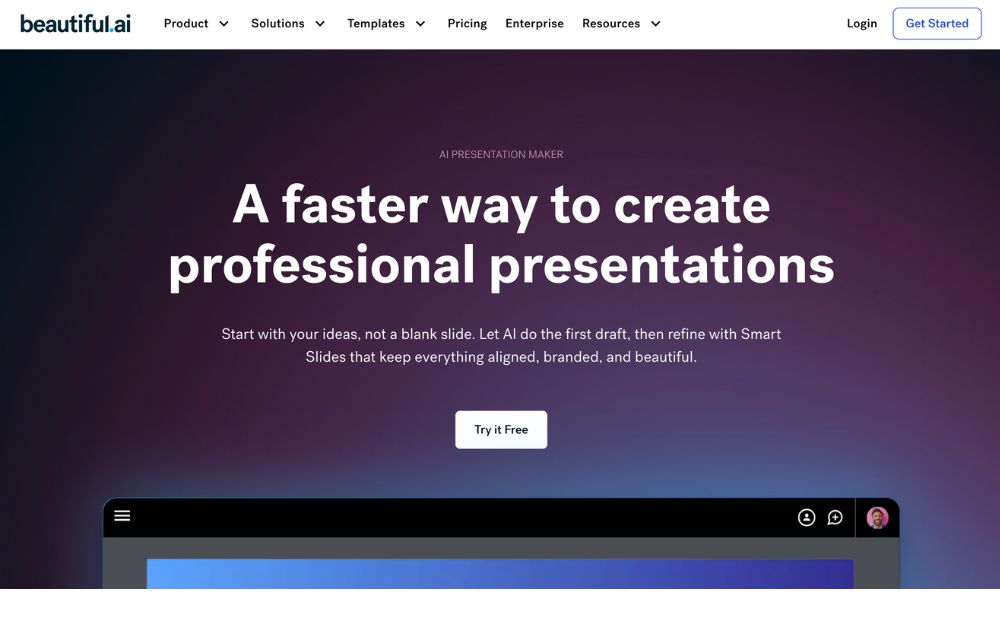
The cloud-based presentation software Beautiful.ai uses artificial intelligence to help users create visually stunning and professional-looking presentations. It has user-friendly and intuitive features, making it easy for users to create high-quality presentations without any design experience.
Best for: Beautiful.ai is a perfect tool for beginners and non-designers.
Pricing:
- Pro plan: $12/month, billed annually
- Team plan: $40/month, billed annually
- Offers a 14-day free trial
10. Zoho Show
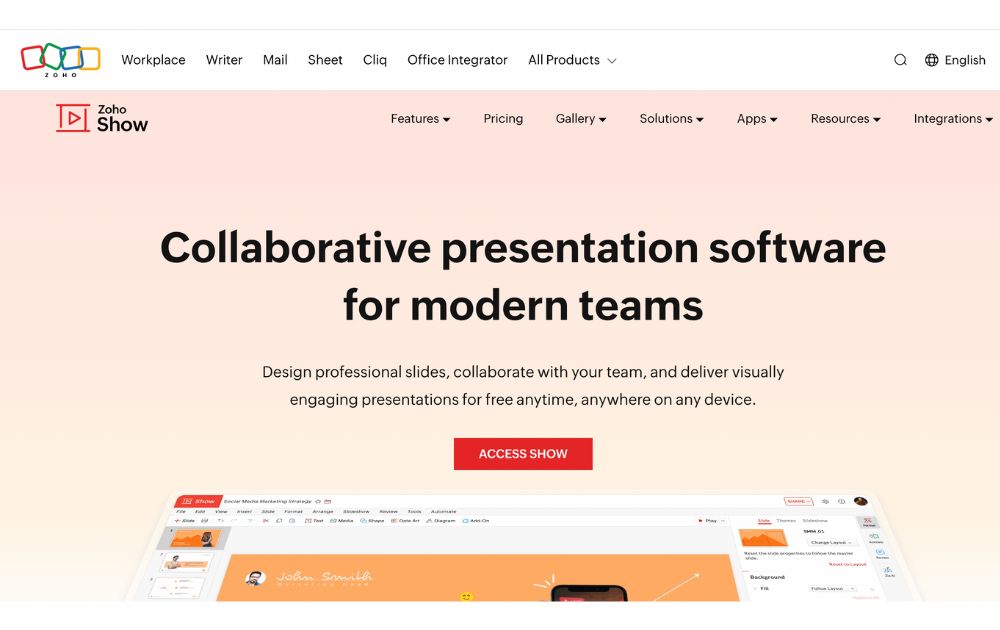
Zoho Show is a web-based presentation software developed by Zoho, a company that provides a suite of productivity and collaboration tools. It is part of the Zoho Office Suite, which also includes tools such as Zoho Writer for word processing, Zoho Sheet for spreadsheets, and Zoho Meeting for online meetings.
With Zoho Show, users can create a new presentation from scratch or use one of the many templates provided. Users can add text, images, charts, and other elements to their presentations using a simple drag-and-drop interface.
Best for: Businesses, entrepreneurs, educators, and students.
Pricing:
- Free plan: up to 5 users
- Paid plans start from $2.5/user/month, paid annually
The Lowdown
Presentation software is the most common tool used to pitch an idea to investors and present proposals to prospective clients. Likewise, it is utilized by many organizations to introduce new products or services, train staff on new policies, or teach students new or complex concepts. The collection of the best presentation software will help broaden your choices regarding the tools that will improve your productivity.
Featured Image Credit: Photo by RDNE Stock project from Pexels
Technology
Top 10 Social Media Scheduler Apps to Automate Your Postings
Published
6 days agoon
December 11, 2025By
Skylar Lee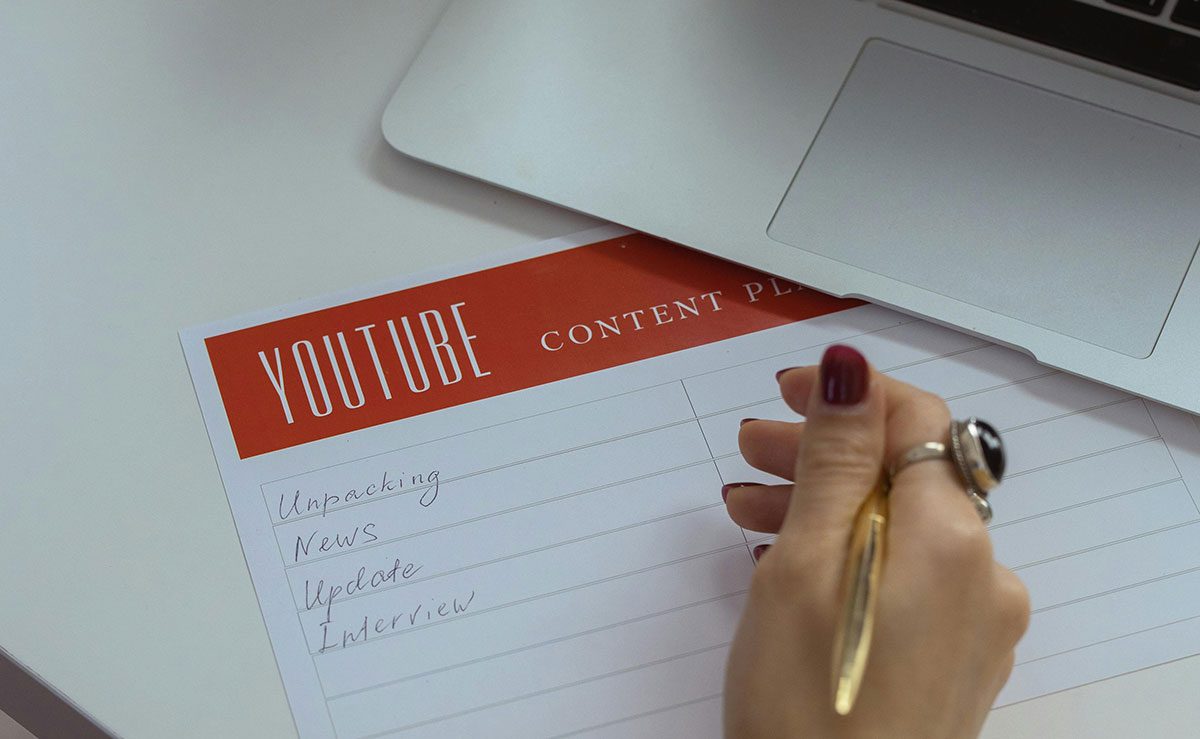
Social media managers have a lot on their plates. Creating, scheduling, and publishing posts can take up a huge chunk of their time. Fortunately, there are social media schedulers that can make your life easy. Here is our list of the 10 best:
Best Time and Day to Post on Social Media
Before we discuss the top 10 social media scheduling apps, you might wonder what the best time is to post on social media. Search Engine Journal and Sprout Social report that the best days to do it are Tuesday through Thursday. Meanwhile, the best time to post it is from 9 AM to 10 AM on those days. Avoid posting on Sundays.
But should you follow this?
The thing is, you don’t have to follow this social media best practice. One way to determine the best day and time to post for your business is through testing. For example, you can post at 2 PM ET for two weeks. Then, you can run a new test by switching to 3 PM after two weeks.
Now, let’s hop into the top 10 social media scheduler apps you can try.
1. Buffer
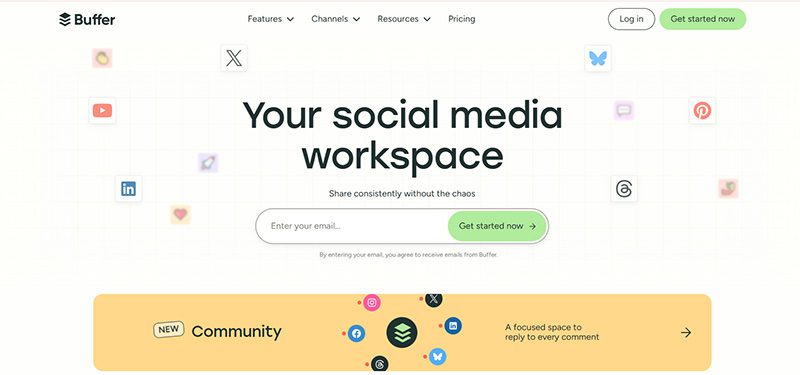
Buffer is an all-in-one social media management tool. Beyond being a social media scheduling tool, it can help you level up your social media marketing. You can add the first comment on your Instagram post and drive more traffic to your website. Aside from that, you have control before publishing your TikTok posts. Buffer will send you a notification, and you can approve the post before it goes out.
Pricing:
- Free
- Essentials – $6/mo/channel
- Team – $12/mo/channel
2. Hootsuite

Hootsuite has been a well-known social media scheduler since the early 2010s. And the social media management tool is still the leading choice for 200,000+ businesses worldwide. Once you subscribe to Hootsuite, you can access its Hootsuite Planner. This enables you to schedule posts at any time. Plus, you can publish bulk posts on different social media channels, such as Facebook, Instagram, Twitter, and LinkedIn.
Pricing:
- Standard – $149/user/mo
- Advanced – $399/user/mo
- Enterprise – Contact sales
3. Agorapulse
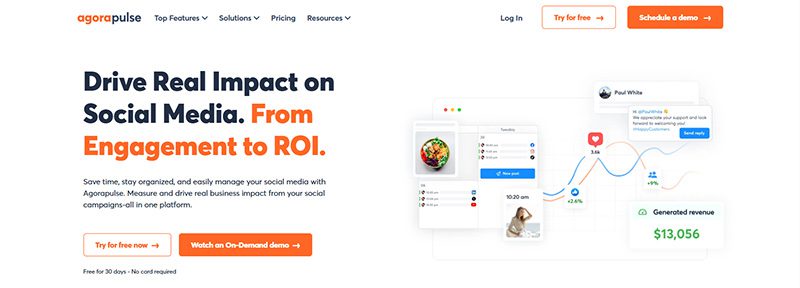
If you need a collaborative social media scheduler, Agorapulse is one of the best options for your team. Team members can approve, reject, and leave feedback on draft posts before scheduling them. And if you manage different brands, you can organize and store files in folders. Aside from that, they have a rescheduling feature. This allows you to republish an old post and promote it again on your social media channels. Plus, if you’re on the go, they have an app too!
Pricing:
- Standard – $99/user/mo
- Professional – $149/user/mo
- Advanced – $199/user/mo
- Custom – Contact sales
4. SocialPilot
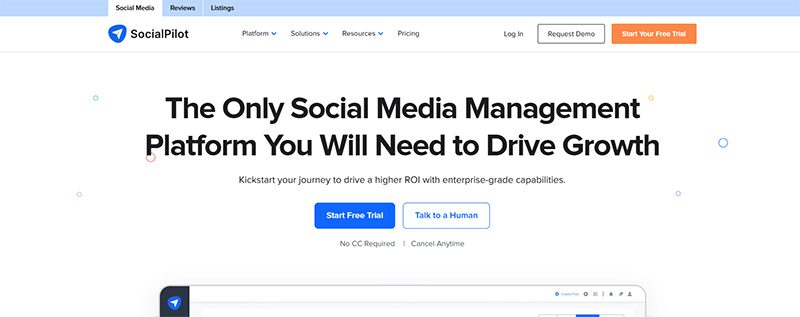
If you want an all-around social media scheduler, SocialPilot should be one of your top choices. You can publish posts on the following platforms:
- TikTok
- YouTube
- Google Business Profile
Aside from that, you can publish 500 posts in one go! You don’t have to worry about posting every week or month. You can be ahead and save time to do other tasks!
Pricing:
- Essentials – $30/mo
- Standard – $50/mo
- Premium – $100/mo
- Ultimate – $200/mo
- Enterprise – Contact sales
5. Sprout Social
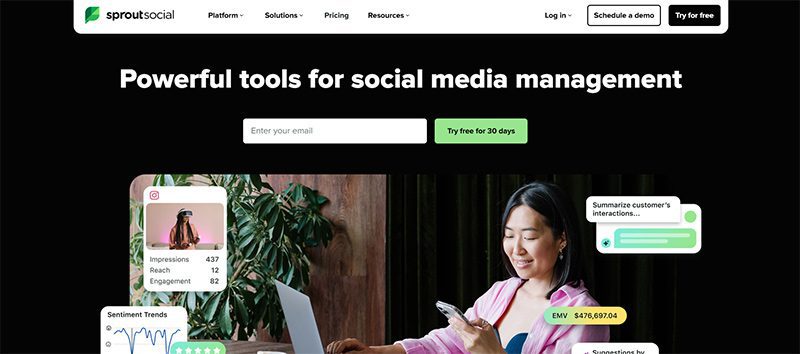
eCommerce businesses and agencies will benefit from using Sprout Social. For eCommerce businesses, they can integrate Shopify and Facebook Shops into Sprout Social. You can share your assets seamlessly on Sprout Social.
Meanwhile, agencies can benefit from Sprout Social’s asset library and message-approval workflows. This allows collaboration between your teams and clients.
Another useful feature of Sprout Social is content suggestions. If you run out of inspiration, Sprout Social can provide post ideas to help you create engaging content.
Pricing:
- Standard – $199/per seat/mo
- Professional – $299/per seat/mo
- Advanced – $399/per seat/mo
- Enterprise – Request a demo
6. MeetEdgar
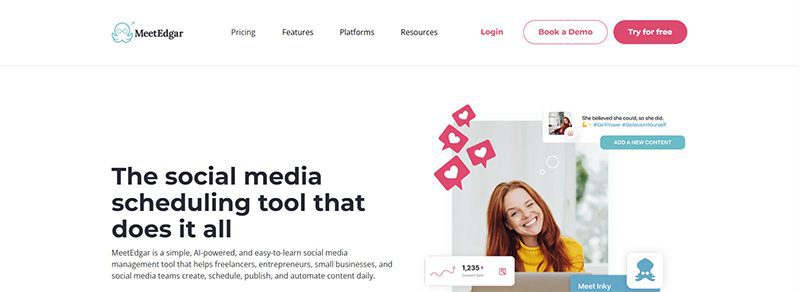
If you want to organize your social media posts according to categories, MeetEdgar should be one of your top choices. The platform allows you to create “Categories.” This enables you to organize the content you want to share on a specific social media platform. Aside from that feature, you can also easily upload your assets to your library and import content. Finally, get an overview of your postings for the next two weeks and review them before they’re published!
Pricing:
- Eddie – $29.99/mo
- Edgar – $49.99/mo
7. SocialBee
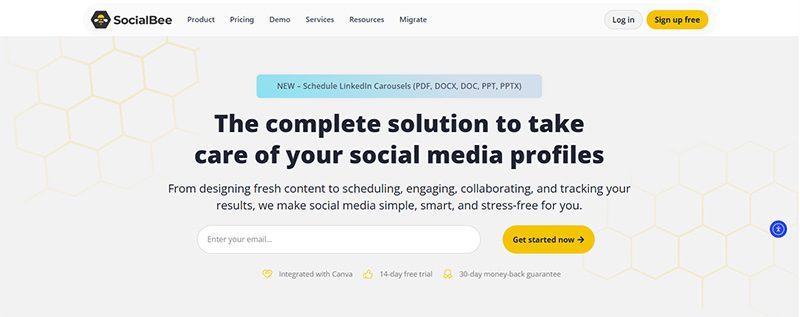
SocialBee is an excellent choice for social media experts who need more control over scheduling and publishing. You can choose to publish your content on ALL active social media platforms or select channels. Plus, SocialBee has a recurring schedule feature where you can repost old content at a later time. However, you can reverse the recurring feature by “expiring” a post. You can stop it when it reaches a number of shares or after a certain time.
Pricing (Standard):
- Bootstrap – $29/mo
- Accelerate – $49/mo
- Pro – $99/mo
Pricing (Agency):
- Pro50 – $179/mo
- Pro100 – $329/mo
- Pro150 – $449/mo
8. Later
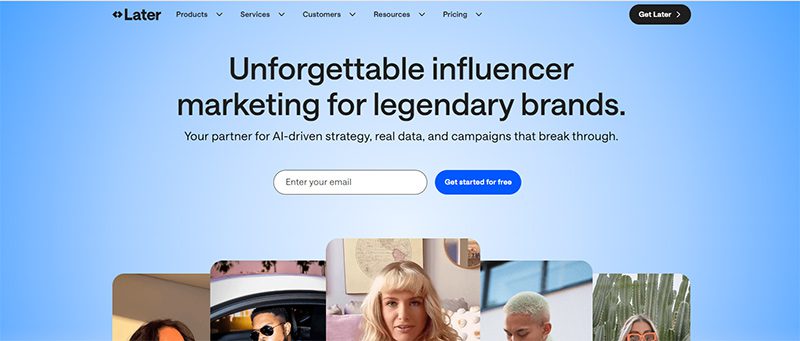
Does your business love reposting user-generated content? Later is the best option for your business. You can follow a hashtag on the dashboard and share the post immediately on your social media channels. When uploading assets, you can use the library or connect your Google Drive or Dropbox account for seamless uploads. Finally, you can download their Chrome extension for faster sharing of images to share on your social media accounts.
Pricing:
- Starter – $25/mo
- Growth – $50/mo
- Scale – $110/mo
9. Pallyy
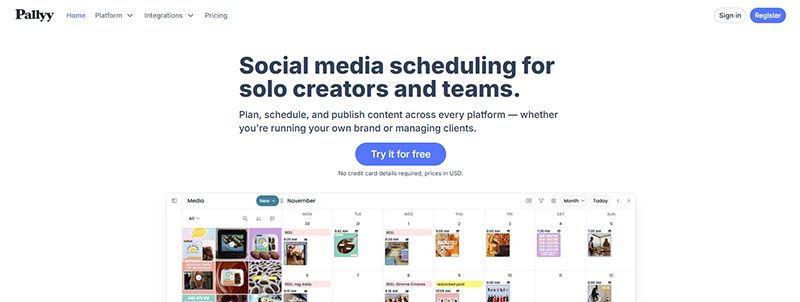
If you run an agency and need a social media scheduling tool, you should consider Pallyy as your primary social media management tool. You can create brand folders to organize posts. You can also select what post you’re publishing on the dashboard. Plus, it’s easy to collaborate with team members and leave drafts for next time. With Pallyy, you can post on popular social media sites like Facebook, Twitter, Instagram, and TikTok.
Pricing:
- Starter – $15/mo
- Pro – $25/mo
- Agency – $99/mo
- Scale – $199/mo
10. Planable

Planable is another social media scheduler focused on team collaboration. Before a team member schedules or publishes a post, other team members can chime in with feedback. Plus, like most apps on this list, you can preview a post before publishing it to your social media channels. Many businesses that use this app have saved time by scheduling multiple posts to various channels.
Pricing:
- Free
- Basic – $39/workspace/mo
- Pro – $59/workspace/mo
- Enterprise – Contact sales
Cruise casino
Bankonbet casino promo code
Vegasino casino no deposit bonus code
Doubledown casino free chips bonus collector
Betano casino online
Casino chateaufarine

What’s the Best Design Agency in Chicago

Top 10 Presentation Software To Use in 2026

10 Best Startup Software for 2026 Every New Business Should Use

Top 10 Social Media Scheduler Apps to Automate Your Postings

How Marketing Optimization Tools Level Up Your Marketing Game

What’s the Best Unlimited Graphic Design Subscription Platform?

What are the Best Kimp Alternatives?
Pinco Casino — a dominant platform throughout the 2025–2026 casino market in Canada
Trending
- Uncategorized3 days ago
Built for long-term growth, Pinco Casino secures its dominance through the 2025–2026 evolution
- Uncategorized2 days ago
BDMBet Sito web ufficiale 450 di bonus + 250 giri gratis
- Business10 hours ago
What’s the Best Design Agency in Chicago
- azurcasino20 hours ago
888 casino willkommensbonus
- cresuscasino24 hours ago
Cadoola casino review
- cresuscasino15 hours ago
Casino 400
- Uncategorized11 hours ago
Casino ohne 5 sekunden regel paysafe
- cresuscasino9 hours ago
Casino chateaufarine
- casino7705 hours ago
Betano casino online
- leonbetcasino4 hours ago
Doubledown casino free chips bonus collector

